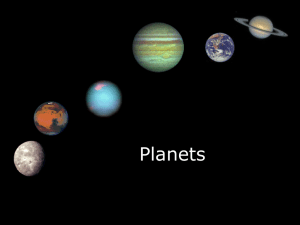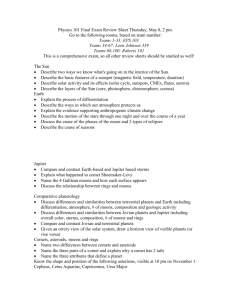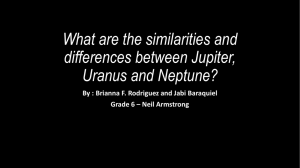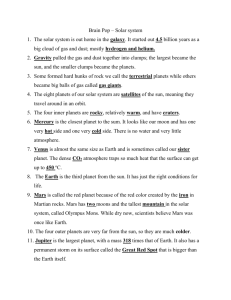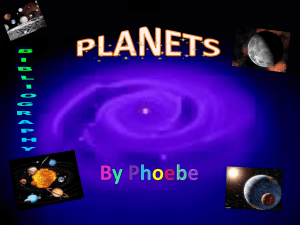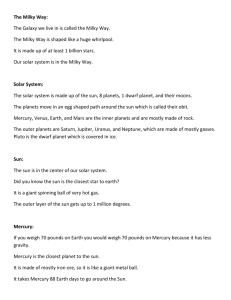JUPITER, NEPTUNE, AND OTHER OUTER PLANETS
advertisement
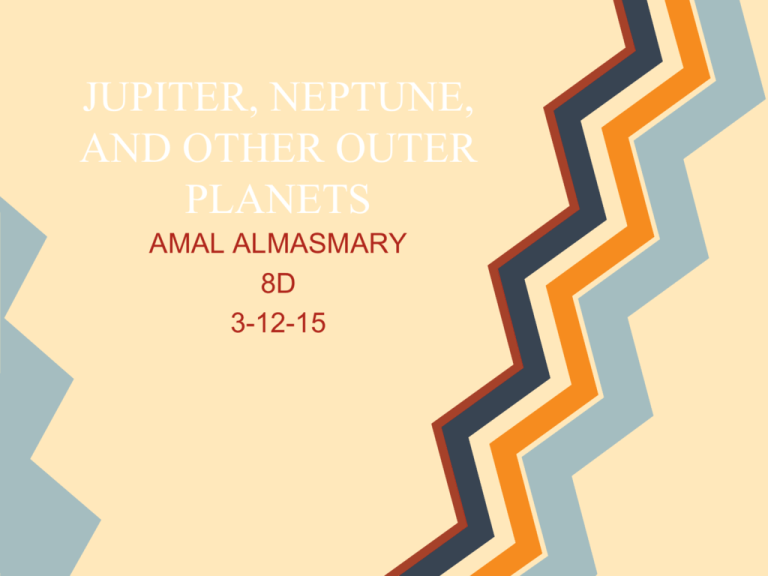
JUPITER, NEPTUNE, AND OTHER OUTER PLANETS AMAL ALMASMARY 8D 3-12-15 VOCABULARY WORDS ● ORBIT- moving around the sun ● PLANET- an object in space that orbits around the sun. ● MOON- an object that orbits a planet. ● ATMOSPHERE- a layer of gas that surrounds a planet or star. ● ASTROID- a rocky object that orbits the sun, but not big enough to be a planet. ● GRAVITY- a force that attracts all objects together. WHAT ARE THE EIGHT PLANETS AND WHAT IS THEIR ORDER? ● Jupiter, Neptune, and other outer planets. ● First 4: Mercury, Venus, Earth Mars. ● Last 4: Jupiter, Saturn, and Neptune. How many days does it take the gas giants to make one orbit? ● ● ● ● Jupiter=4332 days Saturn=10759 days Uranus= 30685 days Neptune= 60189 days What’s beyond Neptune? ● The Kuiper belt: objects like planets ● Pluto is a part of the Kuiper belt. ● Most known object in Kuiper belt: Pluto. ● Oort Cloud: giant cloud of comets. What are Europa and Ganymede? ● Both are moons of Jupiter. ● Europa is smallest of Jupiter’s moons. ● Also same size as Earth’s moon. ● Ganymede is the largest moon in Solar System. What is the difference between the inner and outer planets? ●Mercury, Venus, Earth, Mars. ● Closest to the sun and is rocky, and have few moons or no moons. ● Gas giants-Jupiter, Sarurn, Uranus, Neptune. ● Made mostly of gas. ● Have dozens of moons each. Which planets have rings? ● 4 planets - Gas giants ● Rings around Jupiter, Uranus, Neptune are small, ● ● ● ● dark, hard to see. Saturn, however, has clear rings, and has the most spectacular rings. Jupiter - March 1979 Uranus - 1977 Neptune - 1989 Do all planets have moons? ● Mercury, Venus - no moons ● Earth, Mars - 1 or 2 moons ● ● ● ● ● Gas Giants - dozens of moons Jupiter - 50 known moons Saturn - 53 known moons Uranus - 27 known moons Neptune - 13 known moons How do the planets orbit? ● Farther from sun, slower the orbit. ● Sun isn’t in the middle. ● Planets move closer/farther as they orbit. Is Pluto a planet? ● No longer a planet - Dwarf planet. ● Too tiny, smaller than Earth’s moon. ● However, biggest object past Neptune. How did the planets form? ● 4,600 million years ago. ● Made of gas and dust.(Nebula) ● Gravity pulled particles formed big balls.(planets) ● Material left over - formed moons, other icy objects. Why does the sun play an important role in the solar system? ● Very important to planet Earth. ● Light, heat, energy. ● Freeze to death. ● Earth would be completely frozen. Video: ● https://www.youtube.com/watch?v=ZHAqT4hXn Mw Citations ● "Pluto - Astronomy, Mythology, Astrology." Pluto Astronomy, Mythology, Astrology. N.p., n.d. Web. 25 Mar. 2015. ● Oxlade, Chris.Jupiter, Neptune, and other Outer Planets.New York: The Rosen Publishing group,2008. ● Dunbar, Brian. NASA. NASA, 11 Jan. 2007. Web. 25 Mar. 2015. ● "Sun and Earth." Earthiris. N.p., 09 Jan. 2012. Web. 25 Mar. 2015.



